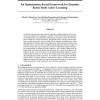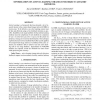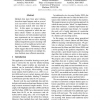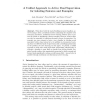228
Voted
ACCV
2010
Springer
14 years 8 months ago
2010
Springer
We present a new active learning approach to incorporate
human feedback for on-line unusual event detection. In contrast to most
existing unsupervised methods that perform passiv...
130
Voted
CVPR
2011
IEEE
14 years 9 months ago
2011
IEEE
In this work, we present an active-learning algorithm for piecewise planar 3D reconstruction of a scene. While previous interactive algorithms require the user to provide tedious i...
142
click to vote
CVPR
2011
IEEE
14 years 10 months ago
2011
IEEE
Active learning techniques have gained popularity in reducing human effort to annotate data instances for inducing a classifier. When faced with large quantities of unlabeled dat...
138
Voted
ICIP
2009
IEEE
14 years 10 months ago
2009
IEEE
Active learning is a framework that has attracted a lot of research interest in the content-based image retrieval (CBIR) in recent years. To be effective, an active learning syste...
111
Voted
ICDM
2009
IEEE
14 years 10 months ago
2009
IEEE
Multispectral remote sensing images are widely used for automated land use and land cover classification tasks. Remotely sensed images usually cover large geographical areas, and s...
96
Voted
EMNLP
2009
14 years 10 months ago
2009
Methods that learn from prior information about input features such as generalized expectation (GE) have been used to train accurate models with very little effort. In this paper,...
103
Voted
ACL
2009
14 years 10 months ago
2009
While Active Learning (AL) has already been shown to markedly reduce the annotation efforts for many sequence labeling tasks compared to random selection, AL remains unconcerned a...
127
Voted
PKDD
2010
Springer
14 years 10 months ago
2010
Springer
Abstract. When faced with the task of building accurate classifiers, active learning is often a beneficial tool for minimizing the requisite costs of human annotation. Traditional ...
96
Voted
PKDD
2010
Springer
14 years 10 months ago
2010
Springer
Active learning [1] is a branch of Machine Learning in which the learning algorithm, instead of being directly provided with pairs of problem instances and their solutions (their l...
105
click to vote
CEC
2010
IEEE
14 years 10 months ago
2010
IEEE
The great majority of genetic programming (GP) algorithms that deal with the classification problem follow a supervised approach, i.e., they consider that all fitness cases availab...




